Gradient Dual-Phase Structure Design in Brass: A New Strategy for Balancing Mechanical and Tribological Properties
Abstract
:1. Introduction
2. Materials and Methods
3. Results
3.1. Microstruction of the As-Received Sample
3.2. Microstruction of the USSR Sample
3.3. Mechanical Properties
3.4. Wear Resistance
4. Discussion
5. Conclusions
- (1)
- A gradient dual-phase structured surface layer is prepared in the brass through USSR processing. Detailed microstructure characterization demonstrates this structure is featured by progressive grain coarsening for both α phase to β’ phase and dislocation density reduction with increasing depth.
- (2)
- The USSR sample exhibits exceptional mechanical properties with a high yield strength of 582.4 ± 31.0 MPa and ultimate tensile strength of 775.3 ± 33.9 MPa, while maintaining competitive ductility of 9.3 ± 1.0%. This yield strength is 2.3 times as high as its as-received counterpart.
- (3)
- Quantitative sliding wear under oil lubrication condition demonstrates a 42.32% reduction in wear volume and 40.82% decrease in COF the USSR sample relative to its as-received counterpart, while maintaining identical dominant wear mechanisms, i.e., abrasive wear.
Author Contributions
Funding
Data Availability Statement
Acknowledgments
Conflicts of Interest
References
- Xu, B.; Sun, J.; Han, J.; Yang, Z.; Zhou, H.; Xiao, L.; Xu, S.; Han, Y.; Ma, A.; Wu, G. Effect of hierarchical precipitates on corrosion behavior of fine-grain magnesium-gadolinium-silver alloy. Corros. Sci. 2022, 194, 109924. [Google Scholar] [CrossRef]
- Xu, B.; Sun, J.; Yang, Z.; Xiao, L.; Zhou, H.; Han, J.; Liu, H.; Wu, Y.; Yuan, Y.; Zhuo, X.; et al. Microstructure and anisotropic mechanical behavior of the high-strength and ductility AZ91 Mg alloy processed by hot extrusion and multi-pass RD-ECAP. Mater. Sci. Eng. A 2020, 780, 139191. [Google Scholar] [CrossRef]
- Bahmanpour, H.; Youssef, K.M.; Horky, J.; Setman, D.; Atwater, M.A.; Zehetbauer, M.J.; Scattergood, R.O.; Koch, C.C. Deformation twins and related softening behavior in nanocrystalline Cu–30% Zn alloy. Acta Mater. 2012, 60, 3340–3349. [Google Scholar] [CrossRef]
- Zhang, Y.; He, C.; Yu, Q.; Li, X.; Wang, X.; Zhang, Y.; Wang, J.; Jiang, C.; Jia, Y.; Zhang, X.-C.; et al. Nacre-like surface nanolaminates enhance fatigue resistance of pure titanium. Nat. Commun. 2024, 15, 6917. [Google Scholar] [CrossRef] [PubMed]
- Fang, T.H.; Li, W.L.; Tao, N.R.; Lu, K. Revealing extraordinary intrinsic tensile plasticity in gradient nano-grained Copper. Science 2011, 331, 1587–1590. [Google Scholar] [CrossRef]
- Zhang, P.; An, X.H.; Zhang, Z.J.; Wu, S.D.; Li, S.X.; Zhang, Z.F.; Figueiredo, R.B.; Gao, N.; Langdon, T.G. Optimizing strength and ductility of Cu–Zn alloys through severe plastic deformation. Scr. Mater. 2012, 67, 871–874. [Google Scholar] [CrossRef]
- Sun, J.; Fang, L.; Sun, K.; Han, J. Direct observation of dislocations originating from perfect twin boundaries. Scr. Mater. 2011, 65, 501–504. [Google Scholar] [CrossRef]
- Sun, J.; Yang, Z.; Han, J.; Liu, H.; Song, D.; Jiang, J.; Ma, A. High strength and ductility AZ91 magnesium alloy with multi-heterogenous microstructures prepared by high-temperature ECAP and short-time aging. Mater. Sci. Eng. A 2018, 734, 485–490. [Google Scholar] [CrossRef]
- Zhu, Y.; Wu, X. Heterostructured materials. Prog. Mater. Sci. 2023, 131, 557. [Google Scholar] [CrossRef]
- Gu, L.; Liang, N.; Chen, Y.; Zhao, Y. Achieving maximum strength-ductility combination in fine-grained Cu-Zn alloy via detwinning and twinning deformation mechanisms. J. Alloy. Compd. 2022, 906, 164401. [Google Scholar] [CrossRef]
- Chen, J.; Su, Y.; Zhang, Q.; Sun, J.; Yang, D.; Jiang, J.; Song, D.; Ma, A. Enhancement of strength-ductility synergy in ultrafine-grained Cu-Zn alloy prepared by ECAP and subsequent annealing. J. Mater. Res. Technol. 2022, 17, 433–440. [Google Scholar] [CrossRef]
- Ji, W.; Zhou, R.; Vivegananthan, P.; Wu, M.S.; Gao, H.; Zhou, K. Recent progress in gradient-structured metals and alloys. Prog. Mater. Sci. 2023, 140, 101194. [Google Scholar] [CrossRef]
- Han, J.; Zhang, Y.; Zhang, Z.; Cao, C.; Huang, D.; Sun, J.; Zhao, J. Unveiling the deformation mechanism of high-strength low-alloy structural steel with gradient dislocation-cell structure. Chin. J. Mech. Eng. 2025, 38, 35. [Google Scholar] [CrossRef]
- Guo, J.; He, Q.Y.; Mei, Q.S.; Huang, X.; Wu, G.L.; Mishin, O.V. Gradient microstructure, recrystallization and mechanical properties of copper processed by high pressure surface rolling. J. Mater. Sci. Technol. 2022, 126, 182–190. [Google Scholar] [CrossRef]
- Deng, S.Q.; Godfrey, A.; Liu, W.; Hansen, N. A gradient nanostructure generated in pure copper by platen friction sliding deformation. Scr. Mater. 2016, 117, 41–45. [Google Scholar] [CrossRef]
- Lu, J.Z.; Duan, H.F.; Luo, K.Y.; Wu, L.J.; Deng, W.W.; Cai, J. Tensile properties and surface nanocrystallization analyses of H62 brass subjected to room-temperature and warm laser shock peening. J. Alloys Compd. 2017, 698, 633–642. [Google Scholar] [CrossRef]
- Wang, Y.F.; Huang, C.X.; Wang, M.S.; Li, Y.S.; Zhu, Y.T. Quantifying the synergetic strengthening in gradient material. Scr. Mater. 2018, 150, 22–25. [Google Scholar] [CrossRef]
- Chen, X.; Han, Z.; Li, X.Y.; Lu, K. Lowering coefficient of friction in Cu alloys with stable gradient nanostructures. Sci. Adv. 2016, 2, e1601942. [Google Scholar] [CrossRef]
- Chen, X.; Han, Z. A low-to-high friction transition in gradient nano-grained Cu and Cu-Ag alloys. Friction 2021, 9, 1558–1567. [Google Scholar] [CrossRef]
- Chen, X.; Han, Z.; Lu, K. Enhancing wear resistance of Cu–Al alloy by controlling subsurface dynamic recrystallization. Scr. Mater. 2015, 101, 76–79. [Google Scholar] [CrossRef]
- Liu, Y.; Sun, J.; Fu, Y.; Xu, B.; Li, B.; Xu, S.; Huang, P.; Cheng, J.; Han, Y.; Han, J.; et al. Tuning strength-ductility combination on selective laser melted 316L stainless steel through gradient heterogeneous structure. Addit. Manuf. 2021, 48, 102373. [Google Scholar] [CrossRef]
- Han, J.; Sun, J.; Song, Y.; Xu, B.; Yang, Z.; Xu, S.; Han, Y.; Wu, G.; Zhao, J. Achieving gradient heterogeneous structure in Mg alloy for excellent strength-ductility synergy. J. Magnes. Alloy. 2023, 11, 2392–2403. [Google Scholar] [CrossRef]
- Li, X.; Lu, L.; Li, J.; Zhang, X.; Gao, H. Mechanical properties and deformation mechanisms of gradient nanostructured metals and alloys. Nat. Rev. Mater. 2020, 5, 706–723. [Google Scholar] [CrossRef]
- Sun, Q.; Sun, J.; Fu, Y.; Xu, B.; Han, Y.; Chen, J.; Han, J.; Wu, H.; Wu, G. Preparing thick gradient surface layer in Cu-Zn alloy via ultrasonic severe surface rolling for strength-ductility balance. Materials 2022, 15, 7687. [Google Scholar] [CrossRef] [PubMed]
- ASTM G 133-05; Standard Test Method for Linearly Reciprocating Ball-on-Flat Sliding Wear. ASTM International: West Conshohocken, PA, USA, 2016.
- Pugacheva, N.B. Structure of commercial α + β brasses. Metal Sci. Heat Treat. 2007, 49, 67–74. [Google Scholar] [CrossRef]
- Mousavi, S.E.; Sonboli, A.; Naghshehkesh, N.; Meratian, M.; Salehi, A.; Sanayei, M. Different behavior of alpha and beta phases in a low stacking fault energy copper alloy under severe plastic deformation. Mater. Sci. Eng. A 2020, 788, 139550. [Google Scholar] [CrossRef]
- Yang, J.; Xu, L.; Gao, H.; Li, X.; Pan, H.; Shu, B.; Itoh, T.; Zhu, Y.; Zhu, X. Effect of global constraint on the mechanical behavior of gradient materials. Mater. Sci. Eng. A 2021, 826, 141963. [Google Scholar] [CrossRef]
- Xu, B.; Sun, J.; Wang, L.; Han, J.; Wu, G. Balanced strength and ductility by asymmetric gradient nanostructure in AZ91 Mg alloy. J. Mater. Sci. Technol. 2024, 184, 167–179. [Google Scholar] [CrossRef]
- Luo, P.; McDonald, D.; Xu, W.; Palanisamy, S.; Dargusch, M.; Xia, K. A modified Hall–Petch relationship in ultrafine-grained titanium recycled from chips by equal channel angular pressing. Scr. Mater. 2012, 66, 785–788. [Google Scholar] [CrossRef]
- Xu, S.; Han, Y.; Sun, J.; Zu, G.; Jiang, M.; Zhu, W.; Ran, X. Designing gradient nanograined dual-phase structure in duplex stainless steel for superior strength-ductility synergy. J. Mater. Sci. Technol. 2024, 170, 122–128. [Google Scholar] [CrossRef]
- Zhu, Y.; Ameyama, K.; Anderson, P.M.; Beyerlein, I.J.; Gao, H.; Kim, H.S.; Lavernia, E.; Mathaudhu, S.; Mughrabi, H.; Ritchie, R.O.; et al. Heterostructured materials: Superior properties from hetero-zone interaction. Mater. Res. Lett. 2021, 9, 1–31. [Google Scholar] [CrossRef]


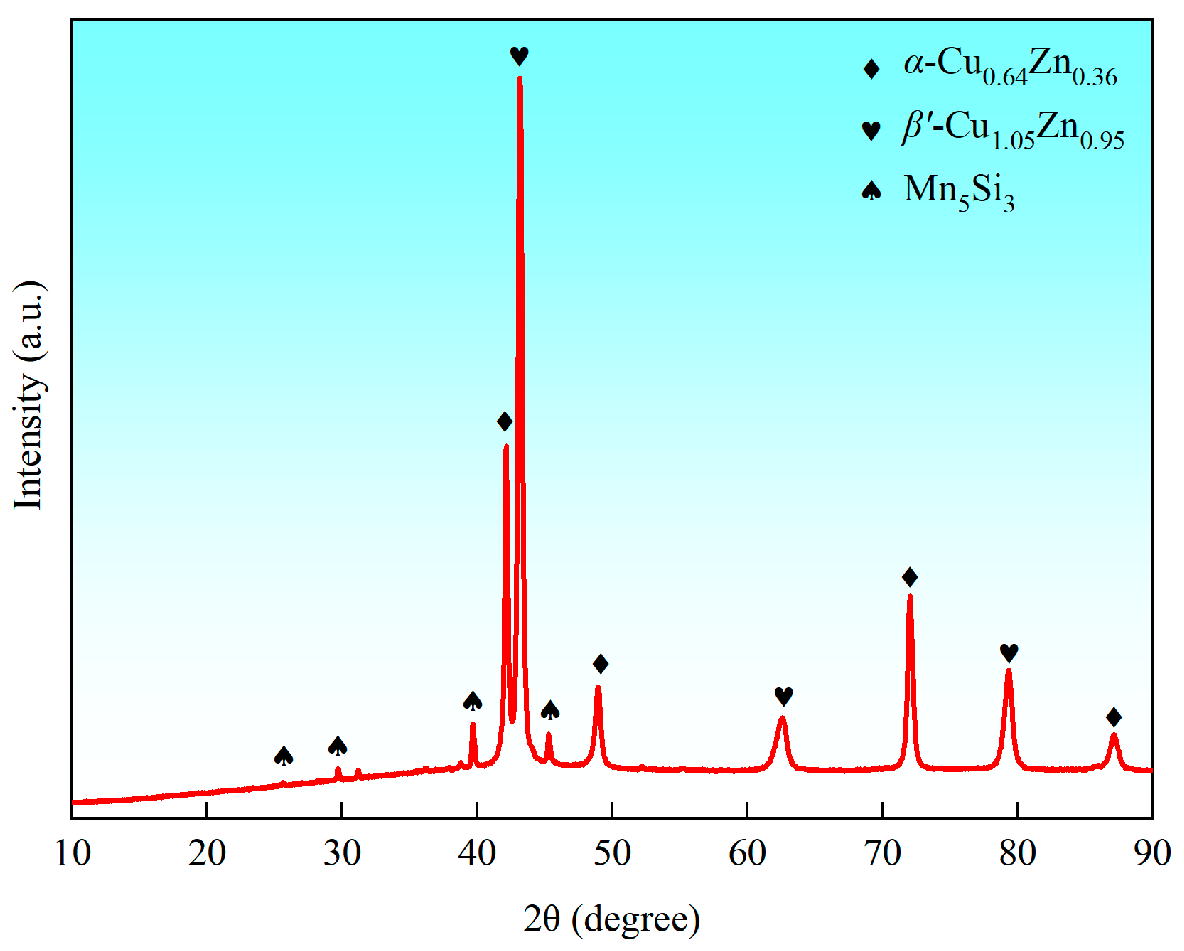




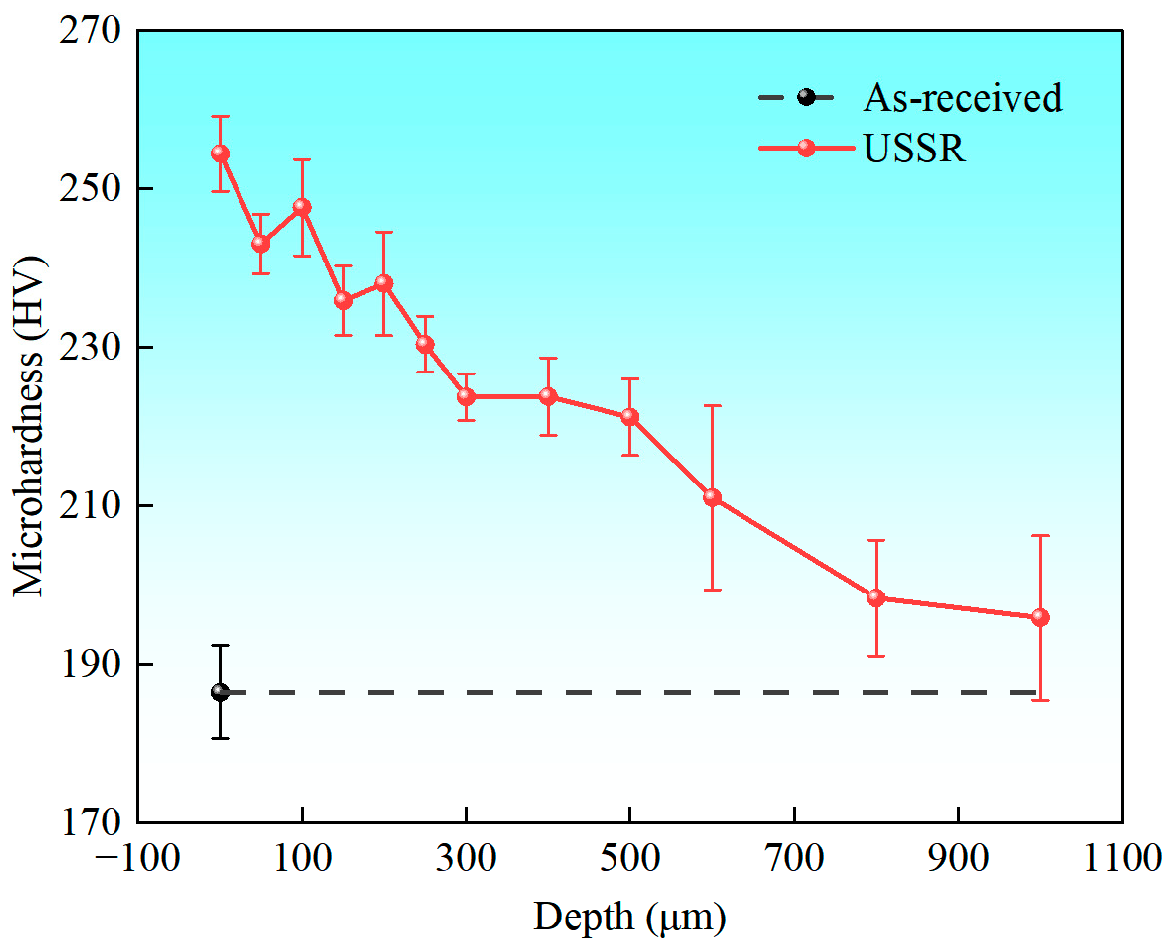


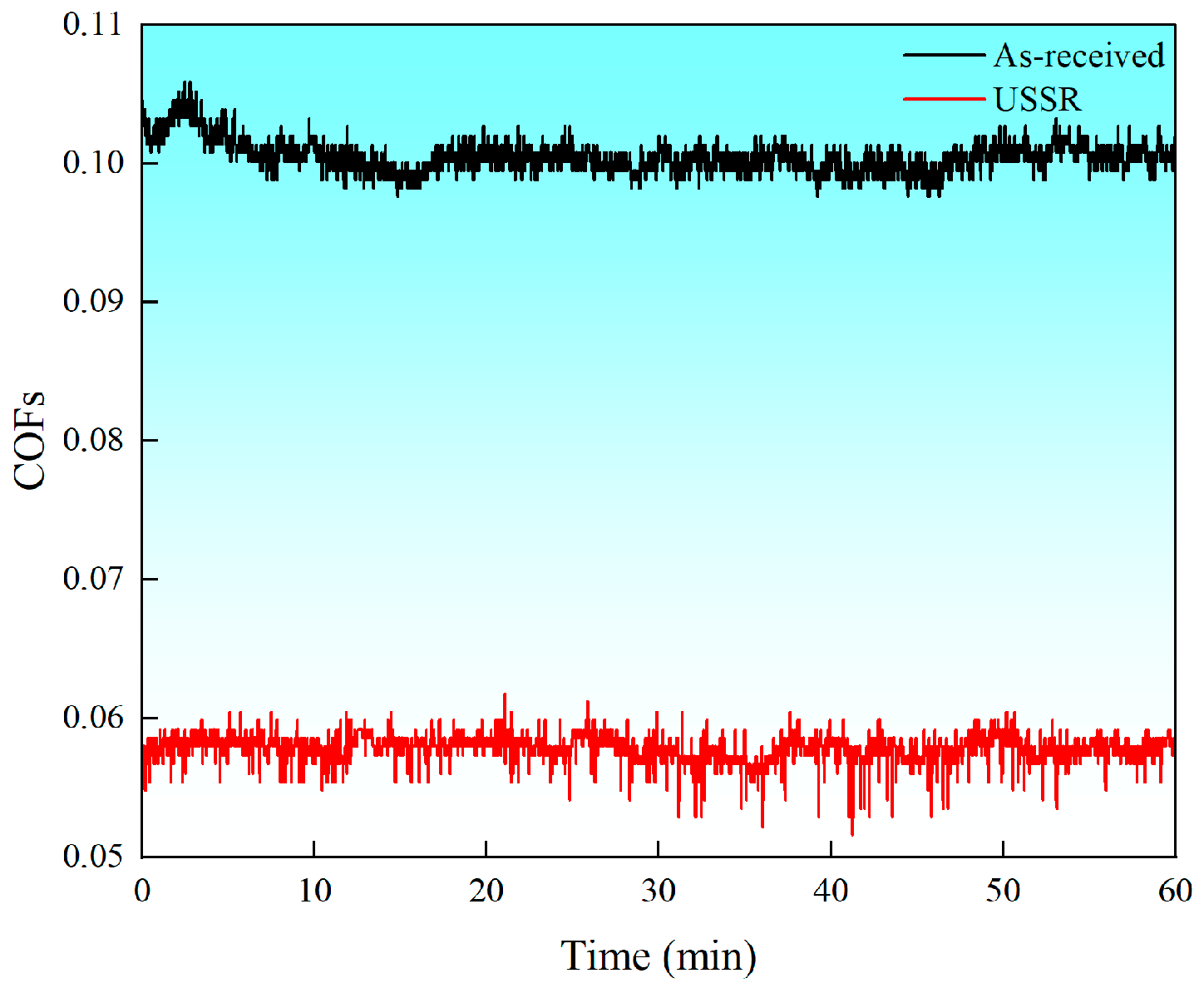
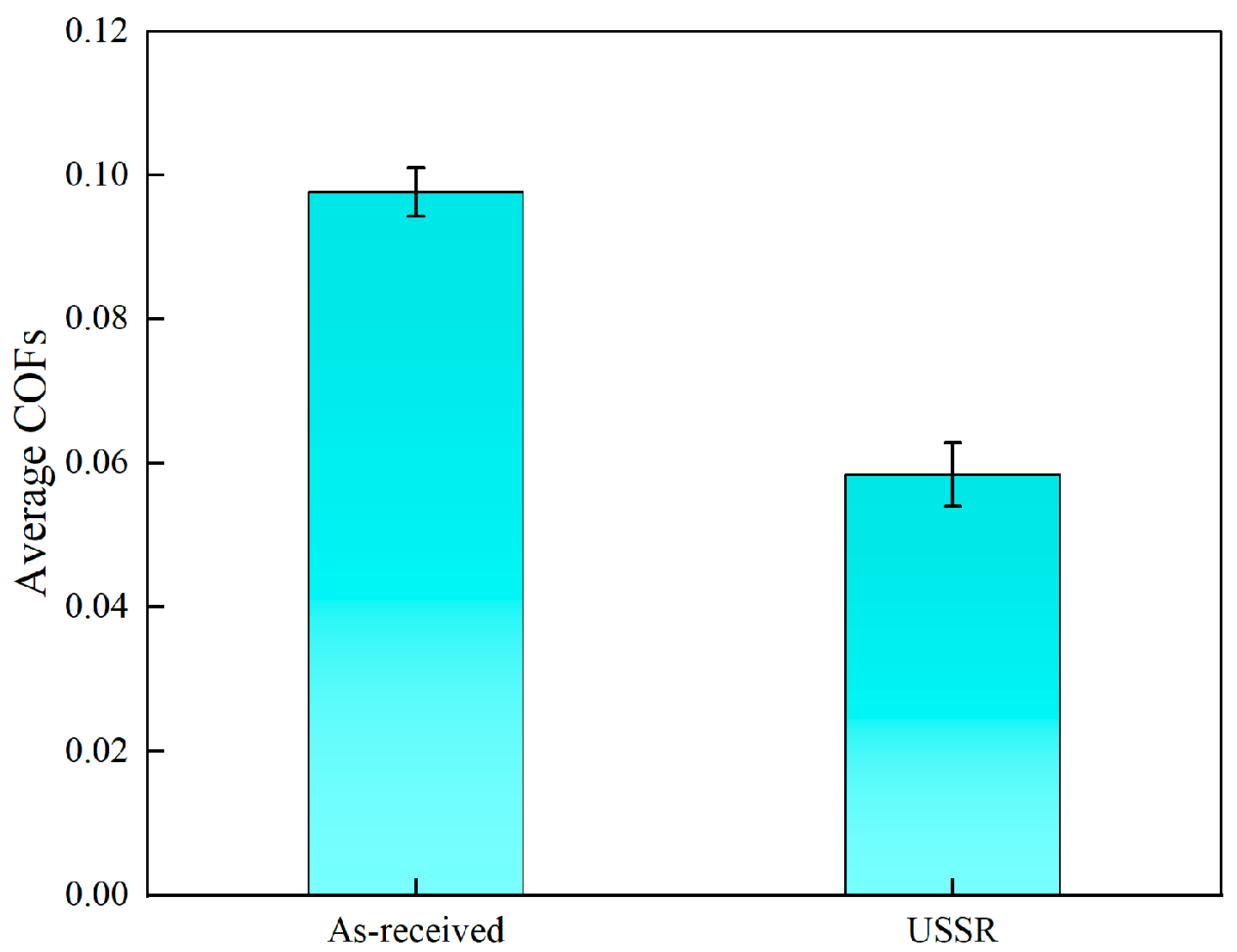
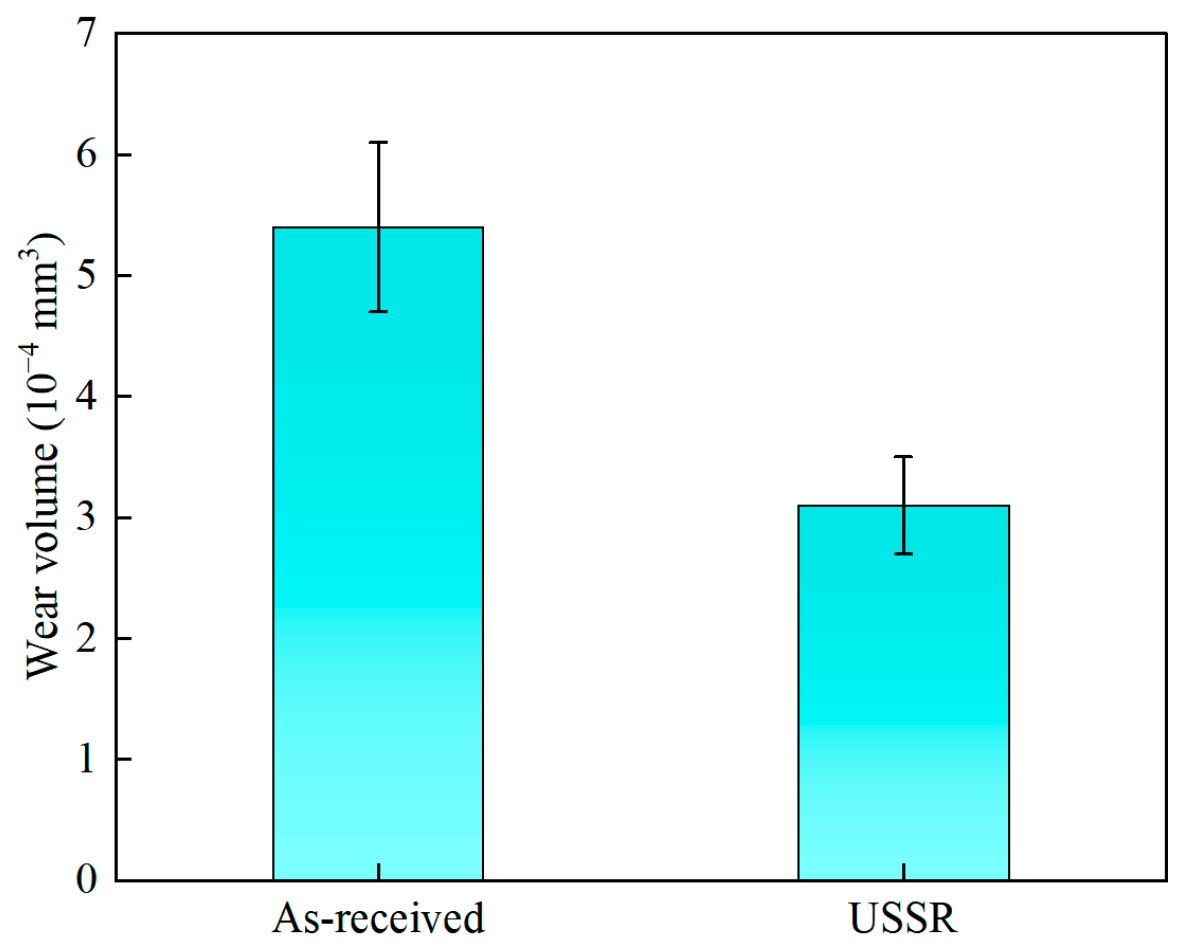
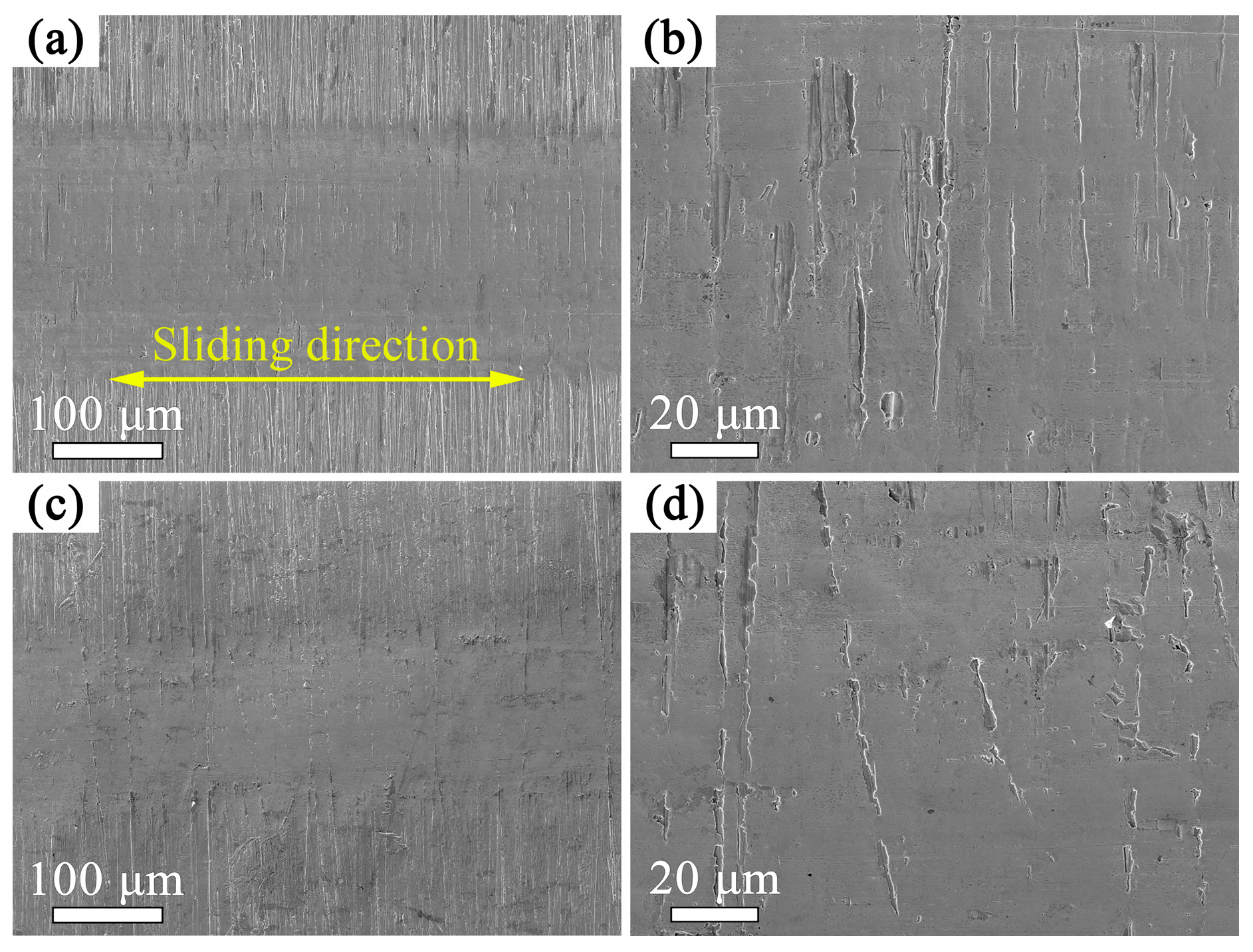
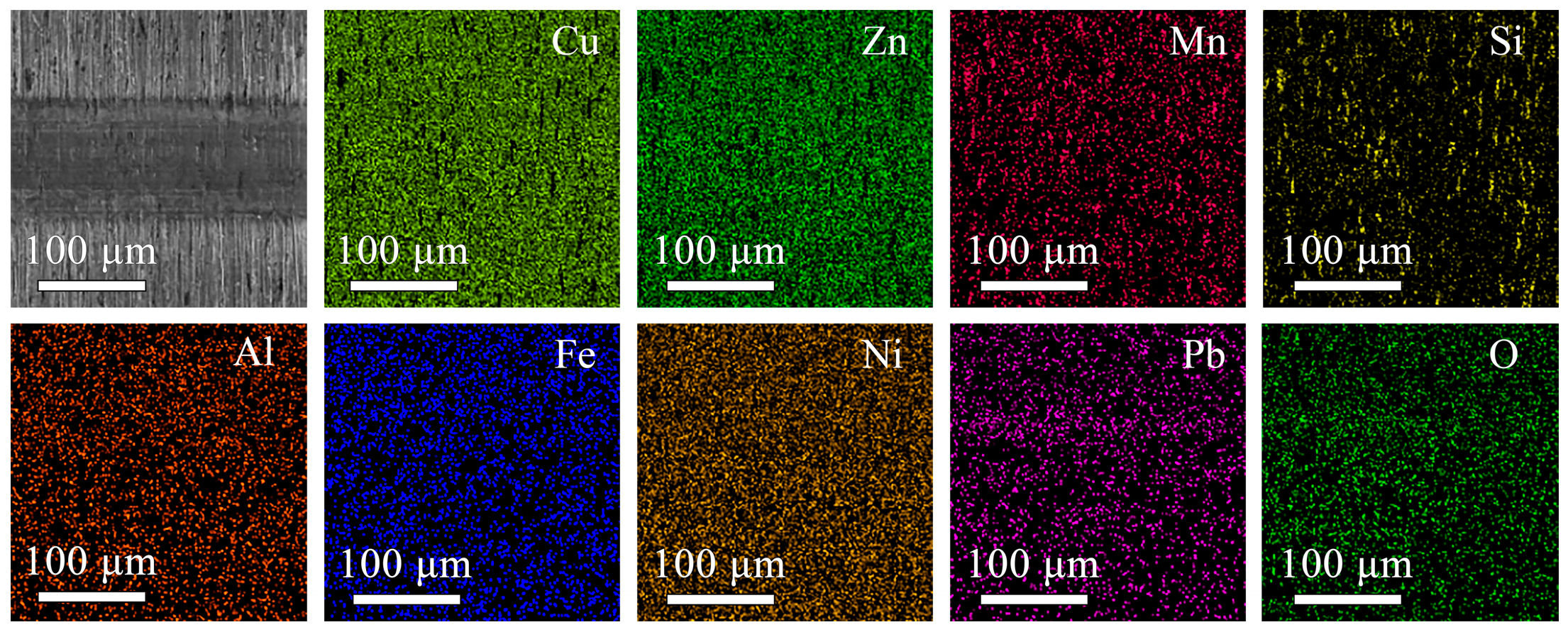
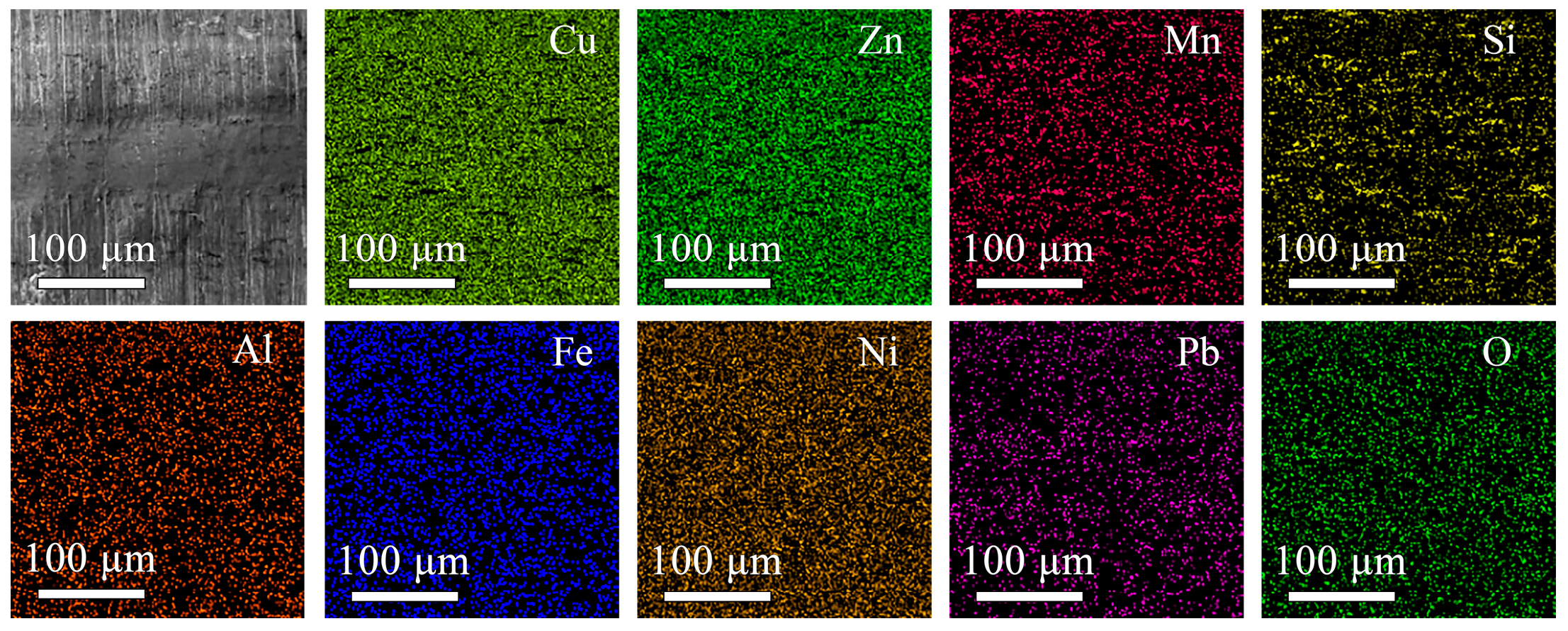
| Element. | Cu | Zn | Mn | Si | Al | Pb | Ni | Fe | Sn |
|---|---|---|---|---|---|---|---|---|---|
| Content (wt%) | 62.72 | 34.48 | 2.48 | 1.55 | 1.13 | 0.36 | 0.15 | 0.09 | 0.07 |
Disclaimer/Publisher’s Note: The statements, opinions and data contained in all publications are solely those of the individual author(s) and contributor(s) and not of MDPI and/or the editor(s). MDPI and/or the editor(s) disclaim responsibility for any injury to people or property resulting from any ideas, methods, instructions or products referred to in the content. |
© 2025 by the authors. Licensee MDPI, Basel, Switzerland. This article is an open access article distributed under the terms and conditions of the Creative Commons Attribution (CC BY) license (https://creativecommons.org/licenses/by/4.0/).
Share and Cite
Han, J.; Zhang, T.; Zhang, B.; Zhang, J.; Zhao, J. Gradient Dual-Phase Structure Design in Brass: A New Strategy for Balancing Mechanical and Tribological Properties. Metals 2025, 15, 515. https://doi.org/10.3390/met15050515
Han J, Zhang T, Zhang B, Zhang J, Zhao J. Gradient Dual-Phase Structure Design in Brass: A New Strategy for Balancing Mechanical and Tribological Properties. Metals. 2025; 15(5):515. https://doi.org/10.3390/met15050515
Chicago/Turabian StyleHan, Jing, Tao Zhang, Bin Zhang, Jing Zhang, and Jiyun Zhao. 2025. "Gradient Dual-Phase Structure Design in Brass: A New Strategy for Balancing Mechanical and Tribological Properties" Metals 15, no. 5: 515. https://doi.org/10.3390/met15050515
APA StyleHan, J., Zhang, T., Zhang, B., Zhang, J., & Zhao, J. (2025). Gradient Dual-Phase Structure Design in Brass: A New Strategy for Balancing Mechanical and Tribological Properties. Metals, 15(5), 515. https://doi.org/10.3390/met15050515






